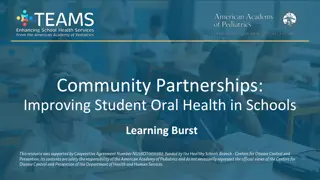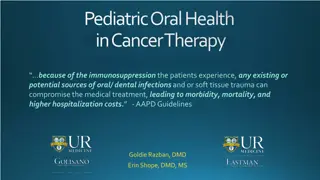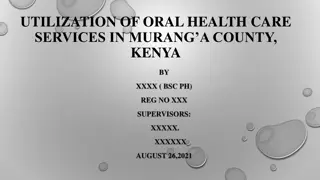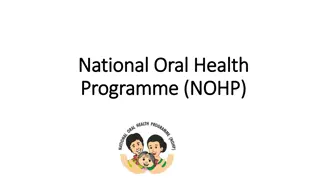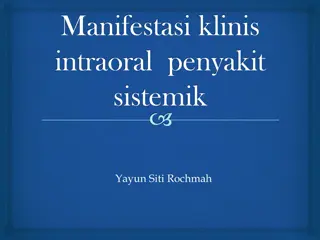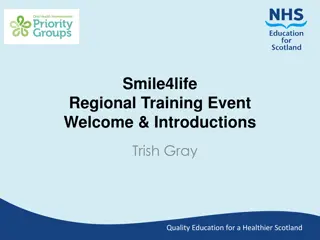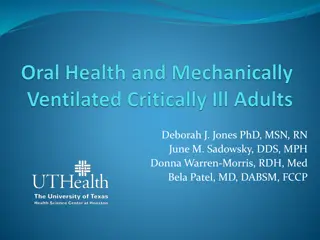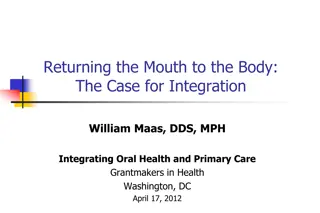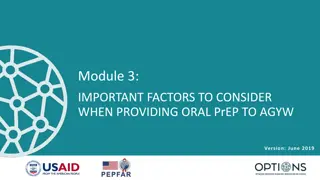
Integrating Traditional Birth Attendants for PMTCT Uptake in Nigeria
This study explores the integration of traditional birth attendants (TBAs) into healthcare service delivery in Nigeria to improve Prevention of Mother-To-Child Transmission (PMTCT) uptake. By analyzing HRH data and healthcare utilization statistics, the research highlights the effectiveness of engaging TBAs in enhancing maternal and child health services. Recommendations include regulating and training TBAs while addressing healthcare workforce shortages and distribution challenges.
Download Presentation

Please find below an Image/Link to download the presentation.
The content on the website is provided AS IS for your information and personal use only. It may not be sold, licensed, or shared on other websites without obtaining consent from the author. If you encounter any issues during the download, it is possible that the publisher has removed the file from their server.
You are allowed to download the files provided on this website for personal or commercial use, subject to the condition that they are used lawfully. All files are the property of their respective owners.
The content on the website is provided AS IS for your information and personal use only. It may not be sold, licensed, or shared on other websites without obtaining consent from the author.
E N D
Presentation Transcript
African Health Economics and Policy Association 4th AfHEA INTERNATIONAL CONFERENCE Rabat, Morocco -26th - 29th September 2016
RE-THINKING HUMAN RESOURCE FOR HEALTH AND THE NEED FOR INTEGRATION OF UNSKILLED BIRTH ATTENDANTS FOR INCREASED PMTCT UPTAKE: PRELIMINARY EVIDENCE FROM NIGERIA Ms. Iboro Nelson, Ph.D (In- view) NIGERIA
Abstract Background: The global community has embarked on the Prevention of Mother-To Child Transmission (PMTCT) of HIV to eliminate new pediatric infections using ante-natal care (ANC) as the first entry point of care. In the absence of any intervention, the possibility of HIV transmission often runs from 15 - 45% and can be reduced to below 5% with effective PMTCT intervention. However, despite concerted efforts by national governments and increase in international donor funding, not much attention is given to analyze the human resource for health requirements to scale up ART and PMTCT services. Meanwhile WHO s Alma Ata Declaration of 1978 states that primary health care shall rely, at local and referral levels, on health workers, including physicians, nurses, midwives, auxiliaries and community workers as applicable, as well as traditional practitioners as needed, suitably trained socially and technically to work as a health team and to respond to the expressed health needs of the community . Over the years, this has been neglected and the results have been continued shortage of manpower to deliver effective health services to the people where it matters most. Objectives: The objective of this paper is to demonstrate that the integration of traditional birth attendants into health care service delivery is effective using available HRH data as well as service utilization data from health facilities over a 12 months period. Method: The paper adopts simple statistical method to analyze disaggregated data of frontline health care workers as well as traditional birth attendants distribution across the entire 31 Local Government Areas of Akwa Ibom State of Nigeria and juxtaposed this with ANC, delivery and PMTCT uptake data from the same area within six (6) years between 2010-2015. The result forms the basis for recommendations made. Results: Key findings from the analysis show that while ANC attendance has increased over the six (6) years under review i.e 38,856 in 2010, 97,392 in 2011, 84,301 in 2012, 54,160 in 2013, 65,442 in 2014 and 79,917 in 2015 respectively, facility deliveries within the same period have however dwindled from 9,000(10.67%), 3,825(7.1%), 531(0.8%) and 1,041(1.3%) between 2012-2015 while the non-facility deliveries consequently increases. Secondly, with a nurse to population ratio of 1:2,067 (from 2015 projected population of 5,272,029 and growth rate of 3.5%) compared with TBA to population ratio of 1:1,883, there is a great shortage of manpower to meet the universal professional and skilled birth delivery targets especially in the face of dwindling resources for health in Nigeria. Thirdly, the high attrition rate of medical workers coupled with urban-biased distribution of available medical manpower severely constraints efforts to increase access to health services including PMTCT. Conclusion and Recommendations: Engaging (regulating, monitoring and re-orientating) TBAs is achievable and effective in improving MNCH services and increasing PMTCT uptake as a short term measure. In the long term, Governments may consider other measures to continuously train and re-train, properly remunerate and distribute health workers appropriately to rural areas.
Introduction In 2013, 15% of the 16 million women living with HIV were aged 15 24 years and 80% of them lived in sub-Saharan Africa (SSA). In 2014, the number of women requiring services for prevention of mother-to-child transmission (PMTCT) was estimated at 1.2 million. Between 2009-2014, 3 countries (Nigeria, South Africa, and Uganda) accounted for almost half of all new HIV infections among children in 2014. With only 15% decline in new infections, Nigeria is the only country among the 3 that achieved less than 30% decline in the number of new infections. Three main steps needed to reduce mother-to-child transmission include early identification of pregnant women who are HIV infected, treatment of HIV-infected pregnant women with antiretroviral therapy (ART), and prophylaxis for HIV-exposed infants.
Introduction 2 A recent study shows that when a collective community effort is focused on these activities, the rate of transmission drops to less than 1% from 15%-45%. The global call to action towards the prevention of vertical transmission of HIV remains the only route to averting pediatric HIV from mothers to the next generation. The national HIV/AIDS goals of Nigeria are to ensure that 80 percent of adults and pregnant women access HIV counseling and testing (HCT) services; 80 percent of eligible adults, children, and HIV-exposed infants receive antiretroviral treatment (ART); and all TB/HIV patients access TB/HIV services.
Introduction 3 Universal skilled attendance at delivery is a worthy objective but in many low income countries including Nigeria, where professional birth attendants are simply not available to rural populations, this ideal remains a distant goal. Theoretically, health outcomes are increasingly recognized as not being shaped only by individual behaviour and more by the wider environments in which people live and make choices, influenced by family and peers, local beliefs and values, cultural norms and practices and political and economic circumstances
Overview of Akwa Ibom State Human Resource for Health (HRH) Situational Analysis Akwa Ibom State-5.16 million as of 2014 projected census, 3,280 health workers employed 659 health facilities(one Federal Government Hospital, 22 General Hospitals, 11 Cottage Hospitals, 14 Comprehensive Hospitals, 351 Health centers and 260 registered Private Clinics and Hospitals). The health worker/population density of the state is 0.63/1000 population (or 6.3/10,000) population. The nurses/midwives, it is 5.6/10,000. This makes the workforce density of the state generally lower than the national average of 85/10,000. As the WHO lower limit for Africa is 2.3/1000 population, the State ration is far lower by all standard.
Figure 1: Distribution of Nurses/Midwives across the 31 LGAs of Akwa Ibom State Eastern Obolo 1% Abak 5% Esit Eket 2% Uyo 16% Eket 7% Urue Offong/Oruko 1% Essien Udim 5% Etim Ekpo 1% Ukanafun 1% Uruan 5% Etinan 6% Udung Uko 1% Oruk Anam 3% Ibeno 2% Oron 3% Ibesikpo Asutan 2% Onna 2% Ibiono Ibom 3% Ika 1% Okobo 1% Obot Akara 2% Ikono 3% Ikot Ekpene 11% Itu 3% Nsit Atai 2% Nsit Ubium 2% Ikot Abasi 3% Nsit Ibom 1% Mkpat Enin 3% Mbo 1% Ini 2%
Figure 2: Composite bar chart showing comparison of distribution of Nurses/Midwives and TBAs across the LGAs in Akw Ibom StateChart Title RED-Nurses/Midwives GREEN-TBAs 149 112 407 269 200121831468689 87 50 90 6855 20271024252 457854 1712449 42 60 5425 431505586 661955188417 2751 68 8812141 32 17 2512929 Nsit Atai 73 Urue Offong/ Oron Uyo Oruko Uruan Oruk Anam Onna Nsit Ibom Okobo Ibeno Ibiono Ibom Eastern Obolo Nsit Ubium Abak Obot Akara Etim Ekpo Ini Ikot Abasi Etinan Mbo Ika Ukanafun Udung Uko Esit Eket Ikono
DATA AND METHOD OF STUDY Data on key indicators of PMTCT were sourced from the HMIS Unit of the Ministry of Health Akwa Ibom State for the periods 2010-2014. The data is cumulative from monthly summary HMIS forms of all the Primary Health Centers (PHCs),secondary facilities as well as the Teaching Hospital in the State excluding data from private health facilities. Data for the periods 2010 - 2012 were sourced from documents outside the DHIS 2.0 while 2013 -2015 were from the DHIS since the State only migrated to the DHIS 2.0 platform in 2013. Data on the comprehensive database of registered Traditional Birth Attendants (TBAs) were on the other hand sourced from the Reproductive Health Unit of the same Ministry of Health in the TBAs Inventory database. To safeguard data accuracy and quality for the purpose of the analysis, data was triangulated with the figures in both the State AIDS and STIs Control Programme Unit of the Ministry of Health. Analysis consisted of simple statistical method(charts and graphs) of disaggregated data of frontline health care workers as well as traditional birth attendants distribution across the entire State. The result is used to make a trend comparison with health service utilization (ANC, delivery and PMTCT uptake data) from the same area for a period of three (3) years.
Table: Health Service utilization data in Akwa Ibom State for 2010-2015 SERVICES YEAR 2010 2011 2012 2013 2014 2015 Total ANC Attendance 38,856 97,392 84,301 54,160 65,442 79,917 Table 3: Health Service utilization data in Akwa Ibom State for 2010-2015 Total Facility Deliveries 4,671 9,587 9,000 3,825 531 1,041 Total Deliveries Non-Facility 34,185 87,805 75,301 50,335 64,911 78,876 Total No. of Pregnant women counseled, tested and receive result 20,876 28,104 26,793 19,364 59,421 65,657 Source: Akwa Ibom State Ministry of Health (HMIS Unit) 420068
Result and Discussion High ANC attendance and low facility deliveries; in years 2012, 2013, 2014 and 2015 respectively, a total of 9,000(10.67%) in 2012, 3,825(7.1%) in 2013, 531(0.8%) in 2014 and 1,041(1.3%) in 2015 and average facility delivery within the period 2010-2015 is 6.8%. The total number of pregnant women counseled, tested and who received result has however increased significantly over the same period from 20,876 ( 53.7%) in year 2010, 28,104 (28.8% ) in year 2011, 19, 364 ( 35.7% ) in year 2013 and 65, 657 (82.1% ) in year 2015 respectively and the average for the six (6) years period is 52.42%. The implication of the increase in the number of total pregnant women counseled, tested and who receive result and the low facility delivery is the high likelihood that most of the reactive cases or pregnant women who tests positives might have delivered outside the health institution with non-skilled birth attendance thus further increasing the chances of infecting them and the general population.
Figure 3: Comparisons of Facilities and Non-Facilities Deliveries in Akwa Ibom State 2010-2015 6 5 4 3 2 1 0 20000 40000 60000 80000 100000 120000 1 2 3 4 5 6 Non-Facility Deliveries 34,185 87,805 75,301 50,335 64,911 78,876 Facility Deliveries 4,671 9,587 9,000 3,825 531 1,041 ANC Attendance 38,856 97,392 84,301 54,160 65,442 79,917 Year 2010 2011 2012 2013 2014 2015
Result and Discussion Another key finding from the analysis- the nurse to population ratio is 1:2,067 (from 2015 projected population of 5,272,029 and growth rate of 3.5%), the TBA to population ratio is 1:1,883. Thus, in terms of spread and coverage, the TBAs are readily available and in large numbers to deliver home services compared to nurses and midwives who in most cases are not readily available especially in the rural areas. Evidence from Nepal, Guatemala, Mozambique, Afghanistan, Malawi lend credence to the need for re- thinking the integration of TBAs into the formal health systems. Other countries with similar programmes are Malaysia, Sri Lanka, Guatemala, Niger, Indonesia, Afghanistan and Mexico.
Result and Discussion The Akwa Ibom State model for integrating TBAs into the health systems is similar to Jigawa and Lagos States and follows Shankar et al. (2008) suggested theoretical framework of eleven essential elements and monitoring points for scaling up skilled attendance in the developing world
Regulation Coordination Monitoring & Supervision (Regulation Guidelines) (Coordination Guidelines) Training PMTCT (PMTCT Guidelines) - Training- Training Guidelines, Curriculum, TOT Manual, Participants manual, Certificate Monitoring and Supervision- Monitoring & Supervision Guidelines, Minimum Standard criteria for Sites of TBAs, Data Quality Assurance Tools, Data Verification Tools, JDs and ToRs, Data Summary sheets, Cards
Recommendation To this end, it is recommended as follows; That the Akwa Ibom State Government operationalizes the TBA integration programme systematically and documents her success and challenge as a pilot for replication to other States. That the National Council on Health considers the integration of TBAs into the formal health systems for the sharing and shifting of some tasks as regards maternal and neo-natal health care. That the international donor organizations should invest in Nigeria s health systems rather than the present single- disease and fragmented approach that is not sustainable.
Conclusion Integrating TBAs into the healthcare systems is achievable and effective judging from evidence and experiences of other developing countries. However, these processes must beentrenched in an extensive support system that includes a referral network, professional mentorship and supervision, and opportunities for employment upon completion of training.

